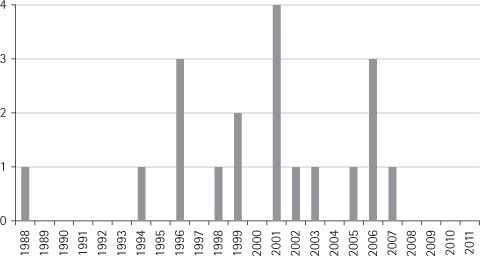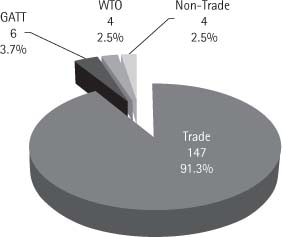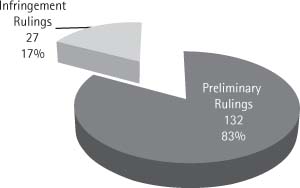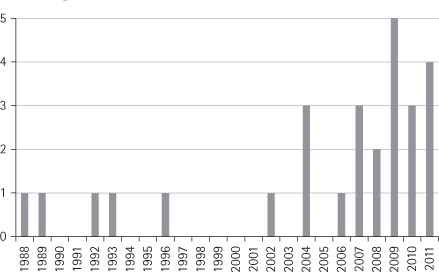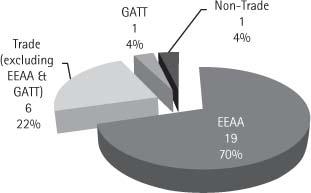Concluding Assessment

1. Introduction
A core premise of this book has been the need for greater empirical work exploring how courts in constitutional systems adhering to automatic treaty incorporation actually deal with treaties when they are invoked, rather than relying on the untested assumption that the particular phrasing of a constitutional provision that provides the point of entry for treaties into the domestic legal arena and/or seminal judicial assertions on their legal effect and status are necessarily reflected in judicial practice. Having explored the body of case law pertaining to key questions on the constitutional status and legal effects of EU Agreements in the EU legal order, it is now possible to consider further the significance of these findings.1 The data-set which formed the basis for the analysis conducted in Chapters II–V contained 337 cases,2 of which nearly all can be grouped into one or more of the following three categories: ex post challenges to the substance or to the procedure for concluding EU Agreements; challenges to domestic action; and challenges to EU action.3 This concluding chapter is structured around the findings pertaining to the three aforementioned core strands of case law.
2. Ex Post Challenges to EU Agreements: The Triumph of Constitutionalism
Ex post challenges to EU Agreements have, as Figure VI.1 illustrates, generated 19 rulings.
Figure VI.1 Ex post challenges to EU Agreements (19 cases)
These 19 cases, which have mainly been annulment actions,4 have involved a total of 18 different Agreements.5 Only annulment actions have ever proved successful (seven of the total 14 annulment actions). And only one of these successful actions resulted from a challenge to the substantive content of an Agreement rather than issues of the appropriate legal basis. The inter-institutional battles over appropriate legal basis appear to be in decline, but they in any event have posed little threat to the internal legal effect of duly concluded EU Agreements given the recourse by the ECJ to maintaining the effects of the annulled decisions and the use of new concluding decisions with retroactive effect.
The catastrophic scenarios that some had envisaged flowing from accepting such review have, thus, clearly not materialized and indeed the case law itself has been rarer than one might have anticipated. Chapter II sought to defend both the need for this form of ex post review, which the EU system is not alone in practising and, crucially, the constitutional appropriateness of depriving EU Agreements, or at least certain of their provisions,6 of their internal legal effect where they are in tension with important constitutional values reflected in EU primary law, even where this outcome cannot be squared with the limited scenarios in which international law allows States and international organizations to invoke their own law vis-à-vis their treaty commitments. The core of the argument advanced was that treaties should not be considered sacrosanct and especially so in an era where they can be, and are, employed to house constitutionally egregious outcomes. The EU–US PNR Agreements of 2004, 2006, and 2007 illustrate precisely why such review should exist. They were bilateral and wholly executive negotiated Agreements in which the Parliament and fundamental rights were sidelined. Such Agreements should not escape the salutary reach of domestic constitutionalism simply because they can hide behind the formal veneer of legitimacy offered by pacta sunt servanda and the Vienna Convention on the Law of Treaties. It is worth noting that two of the most powerful recent contributions against constitutional rights review of legislation are premised on the democratic shortcomings of constitutional review in functioning democratic systems where parliamentarians do have appropriate input into the legislative process.7 Drawing on that logic only serves to bolster the case for accepting the possibility of ex post constitutional review of treaty law, first, because the direct democratic (via the legislature) input into the treaty-making process is usually at best negligible8 and, secondly, because where constitutional review exists vis-à-vis measures with greater input legitimacy (by virtue of being produced via the ordinary legislative process), as in the EU, it is arguably anomalous wholly to immunize other norms simply because they are housed in treaties.9
The only judicial justification expressly offered for ex post review was that the exercise of the powers delegated to the EU institutions in international matters could not escape judicial review of the legality of the acts adopted. The ex ante review jurisprudence, however, has employed the notion of an autonomous legal order to preserve the Court’s exclusive power to interpret EU law.10 And it was also employed in the Kadi ruling, considered further below, in justifying its unwillingness to allow UN Security Council Resolutions to trump EU primary law and, thus, a context sharing parallels with the ex post review authorities. The autonomy of the EU legal order may well be acquiring negative connotations as a rhetorical device to protect the EU legal order from international law or, for those inclined to use such language, as signalling an inappropriate manifestation of dualism.11 Nevertheless, as none of the ex post review authorities have ever actually invoked the notion and because the Court is ultimately being faced with a tension that other constitutional systems with ex post review of treaty commitments must resolve, it is suggested that one can frame the tension as that essentially between constitutionalism and pacta sunt servanda. And, indeed, the development of the EU’s ex post review tools may well offer important insight for constitutional design and practice elsewhere.
3. EU Agreements in Challenges to Domestic Action: Embracing Maximalist Treaty Enforcement
This section first considers some general findings from the case law challenging domestic action, before turning to specific findings pertaining to infringement rulings.
3.1 General findings
The 159 cases involving EU Agreements in challenging domestic action are represented in Figure VI.2.
Figure VI.2 EU Agreements in challenges to domestic action12
Clearly, the case law has been dominated by the trade-related Agreements jurisprudence which represents over 90 per cent of the case law.13 The challenges to domestic action case law has clearly witnessed the embrace of a maximalist approach to treaty enforcement, that is, a model exhibiting a powerful commitment to ensuring the greatest possible effect for this additional category of EU law. There have been at least three core indicators of this.14 First, the ECJ has taken a bold stance to its jurisdiction over mixed agreements. This is of immense significance because this preliminary question needs to be answered in the affirmative for EU law enforcement tools15 to be available at the behest of litigants (including the Commission) for policing domestic compliance with mixed agreements. This boldness was particularly marked in cases such as Demirel, Sevince, Hermès, Irish Berne, Étang de Berre, and LZ VLK, where cogent Member State and/or Council arguments against jurisdiction were rejected. Indeed, LZ VLK was particularly striking for that was a rare case in which the Advocate General too had rejected jurisdiction, and, not unsurprisingly so, given that to do otherwise appears to deprive the EU’s declaration of competence of its intended purpose, namely, to allocate responsibility for breach of Article 9(3) (Aarhus), in the absence of EU legislative activity, to Member States and to this extent by implication to deprive the ECJ of jurisdiction over that provision. In short, jurisdiction over mixed agreements has been interpreted generously indeed, as recognized in most of the literature.16
Secondly, the direct effect lens has been employed in a bold manner that paralleled the evolving approach applied in ‘EU law proper’. The Trade Agreements jurisprudence is the clear manifestation of this: explicitly textually envisaged implementation measures have often not precluded affirmative direct effect findings (eg Kziber, Sevince, Surul, Simutenkov) nor in one controversial case did the absence of imperative language preclude the ECJ from opting to read the verb ‘may’ as if it were indeed imperative (Gürol). Furthermore, the direct effect analysis is often conducted without recourse to an individual rights conceptualization, as was evident in, for example, Anastasiou and, outside the trade sphere, in EDF. In fact, in the Trade Agreements cases concerning goods provisions since Kupferberg, the Court has only framed its inquiry in terms of whether a given provision was ‘directly effective’ when responding to a direct challenge to the direct effect of a provision (Anastasiou and Chiquita Italia) or when rejecting the direct effect of a provision (Katsivardas). For many this approach has much to commend it, as the judicial stance appears premised on a presumption of enforceability. There have certainly been rejections of the capacity of certain provisions to be directly effective. But across the large number of Trade Agreements cases this has been a rare occurrence (Demirel, Taflan-Met, Savas, Katsivardas). With regard to the non-trade Agreements jurisprudence the two relevant cases led to, respectively, a rejection of the direct effect of a specific provision (LZ VLK) and an acceptance of direct effect (EDF). The EDF ruling was a significant development because the Trade Agreements jurisprudence has mainly involved bilateral treaties with States with which the EU has certain ties and they often involve provisions that have directly effective EU law counterparts. This is sometimes viewed as an explanation for the bold judicial stance.17 EDF, however, concerned a non-bilateral environmental agreement and thus attested to the judicial stance being by no means confined to Trade Agreements.18 The negative conclusion on the direct effect of Article 9(3) of the Aarhus Convention in LZ VLK was a predictable outcome given its wording,19 but the ECJ nevertheless enunciated what will likely prove a powerful interpretative obligation on domestic courts nonetheless to seek to ensure their domestic procedural law complies with Article 9(3). The GATT and WTO have been the obvious outliers in this respect in that direct effect was rejected. However, in the GATT era this was combined with an acknowledgement that infringement proceedings could nonetheless be brought, which should remain possible in the WTO era. And, in the WTO era, the obligation to employ the consistent interpretation doctrine vis-à-vis domestic law has, in certain contexts, been emphasized,20 and the possibility of domestic judicial review in those areas outwith the ECJ’s jurisdiction has been preserved. In total the GATT era gave rise to six challenges to domestic action, and the WTO thus far some four cases.21
Thirdly, the substantive interpretation of EU Agreements has been particularly bold. This is patently so in the Trade Agreements jurisprudence where we have often seen the transposition of internal EU law readings, most strikingly in Simutenkov, where the Bosman ruling was transposed to a PCA. This interpretative transposition to the Europe Agreements, much less a PCA, is unlikely to have been anticipated when the Bosman ruling was delivered, given that the judgment appeared heavily conditioned by its fundamental freedoms underpinning. Outside the trade and GATT/WTO cases, which leaves little to consider, it was nonetheless noteworthy that in Étang de Berre, concerning the Barcelona Convention and Mediterranean Sea Protocol, a narrower substantive interpretation of due diligence advanced by France was rejected in favour of a rigorous obligation strictly to limit pollution.
Perhaps what might prima facie appear striking is the dearth of challenges to domestic action invoking the non-trade-related EU Agreements. A mere four cases have been identified (EDF, Étang de Berre, LZ VLK, Trianel), and one of those is in reality about the EU level implementing legislation (Trianel) and two others (EDF, Étang de Berre) arose out of the same factual background. However, the EU actively implements EU Agreements legislatively and this, particularly in the environmental field, results in domestic action being policed using EU law enforcement tools.
A further significant point concerns the institutional dynamics that have been at play in building this especially receptive treaty enforcement model vis-à-vis domestic action for it has frequently been built in the face of dissent from at least some Member States. The Commission, however, has rarely erred on the side of caution. On all three of the aforementioned questions (jurisdiction, direct effect, substantive scope interpretation), it has usually opted for the boldest of readings and the ECJ has usually obliged.22 Rarely has there been anything resembling a common front on the questions before the Court whereby substantial Member State opposition is advanced in unison with the Commission and Council stance.23 This is not altogether surprising, given that the vast majority of this case law has concerned bilateral trade agreements and especially Turkey Association Agreement law. This is significant because the cases often stem from those few countries with sizeable numbers of relevant resident workers and their dependants. Accordingly, whilst opposition to a bold line on direct enforceability or a particular substantive interpretation has often been forthcoming, it has tended to be via submissions from few Member States.24 In effect much of this jurisprudence was built without substantial Member State opposition (in terms of court interventions), which is likely to have impacted on the boldness of the line that the ECJ has usually taken.25
Finally, it must also be acknowledged that the bulk of the cases have concerned a small number of agreements and primarily only a few different types of provision, mainly of the non-discrimination and standstill clause variety and often with similarly worded directly effective EU law counterparts. One might argue that this is as ripe a terrain as possible for a receptive judicial stance particularly as the dominant source of litigation has been the persons-related provisions, thus bringing to the fore the rights of non-EU nationals and their family members where we might expect underlying judicial sympathy.
3.2 Specific findings pertaining to infringement rulings
As Figure VI.3 illustrates, of the 159 cases referred to above, 27 (17 per cent) have resulted from infringement proceedings.
Figure VI.3 Preliminary rulings and infringement rulings
The first of the infringement rulings did not arise until 1988, with 22 of the 26 remaining rulings having come since the turn of the century as illustrated in Figure VI.4.
Figure VI.4 Infringement rulings including pleas of breach of EU Agreement (27 rulings)
The figures, however, are deceptive unless probed further. This demonstrates, as Figure VI.5 illustrates, that a large majority of cases (some 70 per cent) have concerned the EEAA.
Figure VI.5 EU Agreement infringement rulings by type
In addition, the ECJ has only been required to pronounce on one occasion as to a Member State infringement of a non-trade Agreement; the Étang de Berre ruling which, given the generous judicial approach to jurisdiction over mixed agreements exhibited therein, and in cases since (most strikingly in C-240/09 LZ VLK), may well herald greater recourse to infringement proceedings in the large and expanding category of Agreements outside the trade sphere.26 Of these 27 cases, 22 found a breach of an EU Agreement.27
A further significant finding is that, as illustrated in Figure VI.6 below, the vast majority of infringement rulings (close to 90 per cent) have concerned what can be referred to as ‘incidental’ rather than ‘pure EU Agreement’ infringement rulings.
Only three cases (Irish Berne, Étang de Berre, Turkish Residence Permit Charges) involved pure EU Agreement infringement rulings; that is, the alleged violation involved infringement only of an EU Agreement and not also internal EU law provisions.28 To put the point most cynically, one could argue that tacking on a plea of an EU Agreement infringement where EU law proper pertaining to the internal market is at issue does not indicate a marked Commission commitment to this type of centralized enforcement of EU Agreements. It is, however, crucial to recognize that infringement rulings are likely to be merely the ‘tip of the iceberg’ and that, as with ‘EU law proper’, the threat of litigation will frequently result in Member States complying. The initiation of proceedings gives rise to a very small percentage of rulings. The system is built, and in practice operates, to encourage Member States to come into compliance in the pre-litigation stage.29 One would accordingly expect the 27 EU Agreement infringement rulings to form a small percentage of the number of occasions in which Member States have sought to come into compliance with Commission readings of their EU Agreement obligations.30
Figure VI.6 EU Agreement infringement rulings (pure infringement/incidental infringement)
There is a fascinating recent example of the powerful compliance-inducing impact of infringement proceedings in the EU Agreement context.31 In January 2011 the UK received a reasoned opinion giving it two months to act in respect of the Race Relations Act 1976 which permitted nationality-based direct and indirect pay discrimination of non-UK seafarers.32 UK law was considered to infringe EU law as concerned EU nationals,33 and over a dozen EU Agreements containing the equal treatment clause pertaining to working conditions, remuneration, and dismissal.34 Within six months, a legislative instrument was passed making such pay discrimination unlawful vis-à-vis EEA nationals and those of States that were parties to the relevant EU Agreements.35 That this change was forced upon the UK by EU law and the threat of both the penalty payment procedure and individual compensation claims was made abundantly clear during the legislative process.36 Two additional points are worth noting. First, the Commission was clearly not pursuing pure EU Agreement infringements although one suspects that had the UK legislation been compliant with EU law proper—that is, not discriminated against EU nationals (and for that matter been EEAA-compliant)—infringement proceedings would still have been pursued given the many EU Agreements involved. In any event, whether it was a pure EU Agreement infringement proceeding or not, the outcome for those working or aspiring to work in the relevant sector who are nationals of the many States party to the EU Agreements at stake (including the Cotonou Agreement to which 79 ACP States are party), is that the compliance-inducing enforcement machinery of EU law has generated a favourable outcome. Secondly, the UK has come into compliance with a number of Agreements that have yet to be the subject of ECJ litigation.37 This raises two possibilities. The first is that direct effect was a foregone conclusion as the equivalent provision in a range of Agreements had long been held directly effective including in relation to the least integrationist of agreements, the Russian Partnership Agreement (Simutenkov). The difficulty with this is it raises the issue of the value of the first stage of the direct effect determination concerning the nature and purpose of the Agreement.38 The second is simply that direct effect will not be relevant where EU Agreements are the basis for infringement proceedings.39
